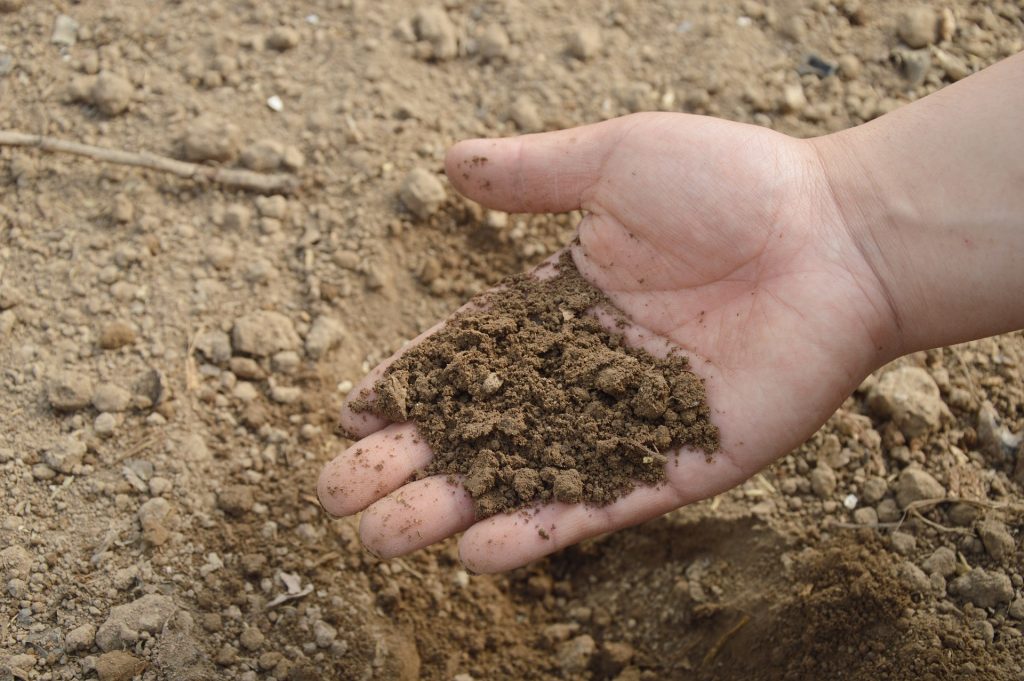
Soil is the basis of every lawn. It anchors your grass, and it is the storehouse for all the nutrients your turf needs. Plants, including grass, need nitrogen, phosphorus, and potassium to grow, and all three are absorbed from the soil. Water, another vital food for your lawn, is also absorbed from the soil. Since soil is the source of your plant’s food, proper soil management is critical to growing healthy turf and a beautiful lawn.
What is Soil?
Soil is made up of four main components: minerals, organic matter, water, and air. It is the result of processes of erosion and decomposition over hundreds or even thousands of years. The minerals in the soil are the oldest component in soil. They are tiny pieces of rock that have been crushed by thousands or even millions of years of erosion and geological forces. The organic matter is typically much younger, anywhere from a few months to a few years. It is composed of decayed plants and animals. The amount of air and water in the soil depends on soil texture and other external conditions.
![Soil Management for Your Lawn [infographic]](https://theturfgrassgroup.com//wp-content/uploads/2020/06/Soil-Management-for-Your-Lawn-infographic.jpg)
Types of Soil
Scientists who specialize in soil management categorize soil by the relative proportions of three main ingredients: silt, clay, and sand. Silt, clay, and sand are all minerals, but they differ in size. The smallest particles make up clay, the largest particles are sand, and silt is in between. Ideal soil is made up of equal parts clay, silt, and sand. Such a balanced soil is called loam. However, most soil is not perfectly balanced. A soil with more clay and equal parts silt and sand would be considered a clay loam. If the soil has more sand and equal parts silt and clay, it would be considered a sandy loam. Terms such as silty clay, sandy clay loam, and similar designations describe the proportions of these three basic ingredients.
Soil with a high proportion of clay typically drains water slowly and takes longer to dry and to warm up. It can be highly fertile but is prone to being too compacted, making it hard for plants to get the air and water they need.
Sandy soil is the opposite of clay. The most extreme example of sandy soil is the sand on a beach. Sandy soil drains quickly and may not hold water as well. It also warms up quickly. Sandy soil is often less fertile and doesn’t retain the water plants need.
Soil Texture
Soil is also categorized by texture, or how the soil clumps together. The proportions of clay and sand in the soil, along with the amount and type of organic matter, contribute to its texture. On one extreme, you have beach sand that doesn’t hold together at all. Very little can grow on a beach. On the other extreme, you have pure clay similar to potter’s clay. It holds together as a tight ball, which makes it very hard for plants to take root. Most soil is somewhere in between, falling into clumps as you run it through your hands.
Soil pH
Besides the proportions of clay, silt, and sand, one of the most critical features of your lawn soil is its pH. pH is a scale from 1 to 14 that measures how acidic or alkaline a substance is. 7.0 is neutral, the pH of pure water. Lower numbers indicate a substance is acidic, while higher numbers indicate a substance is more alkaline. For example, vinegar is pH 3, and baking soda is pH 11.
The ideal pH for most plants, including turfgrass, is between 6 and 7, or slightly acidic. This is because some of the chemical reactions that take place in soil and help with the exchange of nutrients occur best in a slightly acidic environment. Most rain is slightly acidic, so in areas with lots of rain, the soil is often more acidic. Certain other factors, like pine needles dropped from evergreens, can also increase soil acidity. In the West and Southwest, where the climate is mostly hot and dry, the soil may be more alkaline.
Soil Fertility
With think of fertility as the overall ability of soil to support plant growth. While that is not wrong, in a technical sense, fertility refers to the presence of necessary nutrients in the soil. There are three primary nutrients all plants, including turfgrass, need to survive and thrive. Nitrogen is necessary for leaf growth. It helps plants grow and become green. Phosphorus is crucial for healthy root growth, as well as seed development. Potassium makes your turf more disease and drought-resistant. In addition to these three vital nutrients, other minerals such as iron, calcium, magnesium, and other elements are usually present in trace amounts. They are critical to the health of your soil.
Testing Your Soil
With so many variables to soil health, almost any soil in your lawn can benefit from some adjustments. Before you can adjust your soil, you need to know its current state, including pH and nutrient levels. Some garden stores can perform soil tests, and many county agricultural extensions can also provide the service, usually for a small fee. Typical results include the pH of your soil and the levels of certain crucial nutrients. Soil test results are often accompanied by recommendations for soil amendments, including the addition of lime, fertilizers, or organic matter.
Soil Management for Common Soil Problems
Every soil profile is unique, so the appropriate amendments for the soil in your lawn are unique to your lawn. However, most soil problems fall into a few general categories with similar solutions.
Soil is Compacted
Soil that is too compacted is not conducive to healthy turfgrass growth. It can be compacted over time by foot traffic or even regular mowing. Clay soils tend to become compacted more quickly. When soil is compacted, it doesn’t drain quickly, and water may even puddle on the surface. Standing water increases the risk of disease and fungus. When soil is too compacted, it is harder for roots to penetrate. This reduces root depth and strength and makes it harder for plant roots to absorb vital nutrients. Compacted soil also holds very little air, making it harder for plants and the microorganism that maintain soil health to respirate.
The solution to compacted soil is simple and requires only minimal soil management. In most cases, aerating your lawn will reverse the damage caused by compacted soil. You can learn more about aerating your lawn here. The best way to aerate is with a plug aerator that removes small plugs of dirt from your lawn. By opening up spaces throughout the lawn, aerating creates new pathways for plant roots to access air, water, and nutrients, and reduces the density of the soil.
Soil pH is Too High or Too Low
If the soil pH is too high or too low, you can correct the imbalance by adding either acidic or alkaline substances. Low pH is more common than high pH. Adding lime is a common and simple way to increase the pH of your soil. The easiest way to determine exactly how much lime you need for your lawn is to test the soil. You can look up your local extension here. Most extensions offer soil testing services that include recommendations for improving your soil.
Improving Clay Soil
If your soil has too much clay, it won’t drain well. Clay soils are prone to becoming compacted as the clay in the soil clumps and sticks together, much like potter’s clay. To improve clay soil, experts recommend against adding sand. Instead, the best way to improve clay soil is to aerate and mix in organic hummus or high-quality topsoil. The organic matter prevents the tiny particles that make up the clay from cementing when they are wet or dry. This makes it easier for plant roots, air, water, and nutrients to penetrate the soil. As the organic matter decays, it also releases nitrogen, which helps plants grow.
Improving Sandy Soil
Sandy soil doesn’t hold water or nutrients very well, which is why sandy soil is often less fertile than clay soil. To improve sandy soil, experts recommend adding organic matter, hummus, or topsoil. The organic matter fills the spaces between the sand and helps retain moisture and nutrients. It also helps infertile sandy soil to store and release nutrients more efficiently.
The Right Turf for The Right Soil
If you want to grow great turf, you need to start with great soil management. We hope this article has helped you to understand better how soil impacts your turf and given you some idea of how to manage your soil. But the other half of having great turf is…having great turf! When you purchase TiTuf Bermudagrass or any of our other certified turf varieties, you are getting the best turf from the best growers. You can learn more about each type of turf by clicking the ‘Varieties’ tab in our menu.
